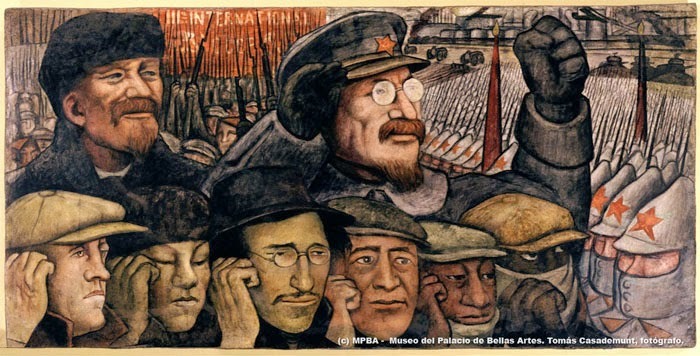“Millions of projectile annihilators were fired during the World War … But none of them had more scope, more decisive intervention in the fate of history, than that train which, carrying the most dangerous and resolute revolutionaries of the century, runs swiftly now from the Swiss border through all of Germany, facilitating their return to Russia, to Petrograd, where they will make jump and shatter the order established until then. (…)
— Stefan Zweig, Stellar Moments of Humanity
As Bhaskar Sunkara puts it in an article recently published in The New York Times, the capitalist economic, political, and social crisis has led to two bourgeois alternatives that are equally pernicious for the masses: the alt-right embodied by Donald Trump and his supporters on one hand and neoliberalism incarnate embodied by the Macron government in France on the other.
Against these two routes, Sunkara proposes to go “back to Finland Station” alluding to the Russian train station at which Lenin’s armored train arrived in the heat of the struggles of 1917.
However suggestive and radical the metaphor, in reality, what Sunkara suggests is to construct “a vision of a transition to socialism that does not require a ‘year zero’ break with the present.” In the eyes of the author, socialism can be constructed in the absence of revolution, that is, without the determined action of the workers and the masses to destroy the capitalist state.
According to Sunkara, since revolution is not the goal, the remaining alternative for the thousands of young people who are increasingly embracing socialist ideas — particularly in the United States and the United Kingdom — is to reclaim the roots of social democracy. That is to say, before social democracy supported its own bourgeoisie in the imperialist carnage of World War I. This “innovative” idea smells musty to us.
To justify the idea of this return to the roots of social democracy (of which the Bolshevik Party was a part before the war), Sunkara commits the same mistake as the detractors of communism do: he identifies Lenin and the Bolsheviks with the bureaucratic degeneration suffered by the Communist Party and Stalinist Soviet Union. Of course, the editor of Jacobin does not brush the Bolsheviks aside with the disdain used by many nay-saying academics, but his logic produces the same dismissive result.
Sunkara detaches himself from the legacy of Bolshevism by stating: “We may reject the version of Lenin and the Bolsheviks as crazed demons and choose to see them as well-intentioned people trying to build a better world out of a crisis, but we must work out how to avoid their failures.”
The Bolsheviks, in particular Lenin and Trotsky, were not merely “well-intentioned people” but strategists of the proletarian revolution and unwavering defenders of mass democracy. It is this strategic legacy that Sunkara omits and it is this omission that allows him to equate social democracy with freedom and true democracy.
A tradition in bankruptcy
German social democracy’s support of its own imperialist bourgeoisie in World War I was not a random error, but the consequence of a strategic drift that was configured in the prewar years.
As Walter Benjamin says in his “On the concept of history” thesis: “The conformism which has dwelt within social democracy from the very beginning rests not merely on its political tactics, but also on its economic conceptions. It is a fundamental cause of the later collapse. There is nothing which has corrupted the German working-class so much as the opinion that they were swimming with the tide.” That is to say, nothing was more harmful for the German workers’ movement than the fact that its leadership abandoned a revolutionary perspective and instead subordinated themselves to capitalist democracy, seeking victories which, under capitalism, always turn out to be ephemeral.
It was this adaptation to the capitalist state and the revision of Marxism to overlook the class-based definition of the nation-state that led the social democrats to support their national bourgeoisie in World War I. While Sunkara may want us to believe that this was a mistake that fell from the sky, it has everything to do with the conception that we can arrive at socialism without destroying the capitalist state.
This peaceful coexistence with capitalist democracy took place during an economic boom. It lasted until capitalist stability imploded, as it always does. This began the period of crises, wars and revolutions. Nowadays, the capitalist crisis and the development of phenomena such as Trump and Brexit make the idea of arriving at socialism without “breaking with the present” an obsolete, utopian fantasy. The failure of the Syriza government in Greece more than adequately demonstrates the fallacy in Sunkara’s logic.
You may be interested in: The Party We Need: A Revolutionary Socialists Party
A heritage useless for Sunkara but vital for the present
Although Sunkara says we should reject the notion of the Bolsheviks as “crazed demons,” without meaning to, he ends up on the side of the most fervent critics of the Russian Revolution. After the experience of Stalinism, it became common practice to equate the dictatorship of the proletariat with the dictatorship of a single party.
This is a fallacy because the concept developed by Marx and recovered by Lenin and Trotsky actually implies two fundamental conditions: mass democracy and the extinction of the State.
Classical Marxists hold that in order to build a new type of democracy, it is necessary to destroy of the capitalist state.
In 1871 the insurgent Paris Commune allowed Marx to see his theoretical program [1] made incarnate. In the foreword to the German edition of the Communist Party Manifesto of 1872, Marx and Engels wrote that “One thing especially was proved by the Commune, viz., that : ithe working class cannot simply lay hold of ready-made state machinery, and wield it for its own purposes.’ “ Likewise, in State and Revolution, Lenin is emphatic that the workers’ revolution would not imply passing the bureaucratic-military machinery of the state from the hands of the bourgeoisie to the hands of the proletariat but would necessitate breaking it entirely.
Breaking the capitalist state means following the example of the Paris Commune: defeating the state’s repressive mechanisms (the police, the military, etc.) and arming the people to defend the worker’s power from the counter-revolution. Their government was based in municipal councils elected by universal suffrage with recallable representatives and those who held public positions made the same salary as a worker.
From this definition, Lenin concludes in “The State and Revolution” that in the transitional society (another term for the dictatorship of the proletariat): “the reduction of the working day that would bring with it the democratic planning of the economy, the radical democratic program, based on the criteria of eligibility and revocability of delegates, the liquidation of material privileges, and the general armament of the population, were to ensure that the state was headed towards its extinction”. That is, the proletarian state is not the dictatorship by a party, but instead the way in which the vast majority of society would be organized democratically.
With great creativity, Russian workers created a new form of organization in 1905. They called the structures of this system, which they had based on direct democracy, soviets. These organisms of self determination democratically organized the struggle against the Czar, but at the same time expressed the seed of a new kind of democracy.
When drawing lessons from the Russian Revolution of 1905, Trotsky concretely articulated how the new workers’ power would emerge, pointing to the role of workers’ councils as an embryo of the state in the period of transition.
The power of the soviets was clearly expressed after the 1917 February Revolution that established dual power between the soviets and the provisional government. In this case, the soviets played the role of democratically organizing, not only the struggle against the czar, but also the everyday functioning of Russian society. This dual power could not coexist with capitalist power for long — the soviets would either take power or be crushed by the bourgeois reaction. This is why the Bolsheviks put forth the slogan “All power to the Soviets”, which led to victory of the Revolution in October of 1917.
Far from a Stalinist bureaucracy, the dictatorship of the proletariat set up by the soviet government was meant to provide the widest form of democracy — far greater than what is possible under capitalism. As the historian E. H. Carr puts it: “The emotional echoes of the word “dictatorship”, while associated with the idea of a few or one alone, was totally absent from the minds of the Marxists who used the phrase. On the contrary, the dictatorship of the proletariat would be the first regime in history in which power was exercised by the class that constituted the majority of the population, a condition to be fulfilled in Russia, leading the mass of the peasants to unite with the industrial proletariat … ” [2]
Workers’ democracy encountered huge obstacles in the years immediately following the seizure of power because the Russian Civil War forced the Bolsheviks to take exceptional measures and strengthened the centralization of power in their hands. However, the democratic character of the Soviet Republic was revitalized in the program of the Left Opposition as well as later on in the program of the Fourth International which fought against Stalinist bureaucratization.
In “The Revolution Betrayed,” Trotsky argues that measures taken during the Civil War, such as the prohibition of factions within the Party and the outlawing of the Socialist and Menshevik parties were meant to be short-lived provisions for the Bolshevik government under attack. These were made common practices by Stalin under the false idea that with the “realization of socialism” classes had disappeared and therefore separate and distinct parties were unnecessary.
Trotsky argued that taking power did not imply the destruction of social classes. Instead, he says that in transitional society: “classes are heterogeneous; they are torn by inner antagonisms, and arrive at the solution of common problems not otherwise than through an inner struggle of tendencies, groups and parties.” This means that a class has many sectors and a party never represents a whole class.
The consequence of Trotsky’s analysis was the development of a program to restore Soviet democracy. It was necessary to fight for the right of criticism and freedom for elections. This assumes “a revival of freedom of Soviet parties, beginning with the party of Bolsheviks, and a resurrection of the trade unions.” Trotsky categorically supported the existence of parties that defended workers power within the dictatorship of the proletariat and the existence of factions within the Bolshevik party.
Break with the Present
It is common for sectors of the Left to omit the contributions of Leon Trotsky when they take stock of the legacy of the Soviet Union and its bureaucracy. Sunkara is not exempt from this problem. This omission is glaring because Trotsky was the only Bolshevik leader who developed a theory, program, and concrete practice to restore workers’ democracy in the Soviet Union and defeat the bureaucracy.
It is only by this major omission that Sunkara can make the argument that democracy is exclusively the terrain of social democrats. The kind of democracy that Sunkara proposes is far from the mass democracy of the soviets and closer to the exclusive “democracy” of the capitalist state — a state that he wishes to reform rather than destroy.
For the new generations that today awaken to political life, embrace the ideal of Socialism, and are part of groups like Momentum in the U.K. or the DSA in the U.S., the legacy of the Russian Revolution and of Soviet democracy must be rekindled. We have to buy a ticket to Finland Station to prepare the new revolutions that will “break with the present” and destroy the bloodthirsty system of capitalism which deserves to die.
Notes:
[1] In the “Critique of the Gotha Program,” Marx sets out the most concrete path for how the proletariat would be organized as a ruling class. He made a distinction between a stage of transition after the overthrow of the bourgeoisie and the resulting state known as the “dictatorship of the proletariat” and communism, where class and the state have been abolished.
[2] E.H. Carr: The Russian Revolution from Lenin to Stalin, 1917-1929, McMillan, 1979.











